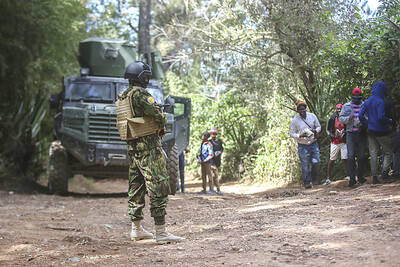The US would like to have a better idea about the intentions behind China’s naval build-up, a senior US navy officer said yesterday, but downplayed worries over Chinese plans for an aircraft carrier.
“The advancement and the growth of the PLA [People’s Liberation Army] navy is consistent with China’s economic advancement and its role in a globalized world,” US Chief of Naval Operations Admiral Gary Roughead told a news conference in Beijing.
“I think it is important however that as we create a naval capability, indeed any military capability, that there should be clear communications with regard to what the intentions of that capability are,” he said.
“That’s why visits like mine are important,” Roughead said, ahead of a trip to the northern port city of Qingdao to attend celebrations to mark the 60th anniversary of the founding of the PLA navy.
The US has long complained that China’s increased military spending lacks transparency, charges Beijing denies.
This year’s US Defense Department annual report on Chinese military capabilities said China was making advances in denying outsiders access to offshore areas and was improving its nuclear, space and cyber warfare capabilities.
Last week a Chinese admiral told state media that China would accelerate development of warships, stealth submarines and long-range missiles as the country makes a stronger navy a priority in military modernization.
Chinese media have also highlighted the government’s hopes to build an aircraft carrier, seen as the badge of a mature ocean-going power, prompting concern in the region about China’s military ambitions and how that could alter the balance of power.
“There has been no doubt in my mind that the acquisition of an aircraft carrier and carrier aviation was something that was clearly an ambition and an objective of the PLA navy,” Roughead said.
“The advent of an aircraft carrier on the part of the PLA navy to me really doesn’t change the nature of our operations at all,” he said. “The real issue is: How are those aircraft carriers used and what is the intent of that capability?”
Tensions between the US and China rose last month over an incident in the South China Sea in which five Chinese ships jostled with the Impeccable, a US Navy surveillance vessel.
The US said its ship was in international waters, but Beijing said the US ship was in the wrong and Chinese naval officers argued that it violated their country’s sovereignty.
“It’s important that we adhere to international law even though there may be some different interpretations. We must continue to operate in accordance with the rules of the road ... and most importantly that we operate safely,” Roughead said.
Still, the admiral said he wanted greater cooperation with China in areas like search and rescue and humanitarian missions, highlighting joint efforts to combat piracy in the seas off Somalia.
“The opportunity for our navies to work together against the threat of piracy is very important,” Roughead said.

A fire caused by a burst gas pipe yesterday spread to several homes and sent a fireball soaring into the sky outside Malaysia’s largest city, injuring more than 100 people. The towering inferno near a gas station in Putra Heights outside Kuala Lumpur was visible for kilometers and lasted for several hours. It happened during a public holiday as Muslims, who are the majority in Malaysia, celebrate the second day of Eid al-Fitr. National oil company Petronas said the fire started at one of its gas pipelines at 8:10am and the affected pipeline was later isolated. Disaster management officials said shutting the

DITCH TACTICS: Kenyan officers were on their way to rescue Haitian police stuck in a ditch suspected to have been deliberately dug by Haitian gang members A Kenyan policeman deployed in Haiti has gone missing after violent gangs attacked a group of officers on a rescue mission, a UN-backed multinational security mission said in a statement yesterday. The Kenyan officers on Tuesday were on their way to rescue Haitian police stuck in a ditch “suspected to have been deliberately dug by gangs,” the statement said, adding that “specialized teams have been deployed” to search for the missing officer. Local media outlets in Haiti reported that the officer had been killed and videos of a lifeless man clothed in Kenyan uniform were shared on social media. Gang violence has left

US Vice President J.D. Vance on Friday accused Denmark of not having done enough to protect Greenland, when he visited the strategically placed and resource-rich Danish territory coveted by US President Donald Trump. Vance made his comment during a trip to the Pituffik Space Base in northwestern Greenland, a visit viewed by Copenhagen and Nuuk as a provocation. “Our message to Denmark is very simple: You have not done a good job by the people of Greenland,” Vance told a news conference. “You have under-invested in the people of Greenland, and you have under-invested in the security architecture of this

Japan unveiled a plan on Thursday to evacuate around 120,000 residents and tourists from its southern islets near Taiwan within six days in the event of an “emergency”. The plan was put together as “the security situation surrounding our nation grows severe” and with an “emergency” in mind, the government’s crisis management office said. Exactly what that emergency might be was left unspecified in the plan but it envisages the evacuation of around 120,000 people in five Japanese islets close to Taiwan. China claims Taiwan as part of its territory and has stepped up military pressure in recent years, including